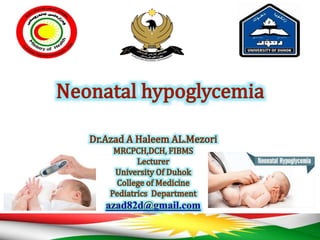
Preventing and Treating Neonatal Hypoglycemia
- 2. Introduction • Glucose or dextrose is a vital source of nutrient energy and is required continuously by the fetus. • Neonate needs this as either intermittent oral feeds or continuous IV fluids. • Hypoglycemia can cause long term neurologic sequelae. The important steps in preventing and treating hypoglycemia are to identify neonates at risk of developing hypoglycemia to recognize symptoms of hypoglycemia, early feeding and to initiate IV fluid therapy, where ever needed.
- 3. Neonates at risk of hypoglycemia o Babies weighing less than 2.0 kg birth weight, o preterm babies, o LGA (large for gestational age) babies especially those weighing more than 3.5 kg, o infants of diabetic mothers, o those with delayed cry at birth, any sick neonate who is not sucking or accepting feeds are all at risk of developing hypoglycemia. o The other risk factors for hypoglycemia are RDS, polycythemia, shock, and hypothermia
- 4. Definition of hypoglycemia • Neonatal hypoglycemia, defined as a plasma glucose level of less than 30 mg/dL (1.65 mmol/L) in the first 24 hours of life and less than 45 mg/dL (2.5 mmol/L) thereafter, • Neonatal hypoglycemia is the most common metabolic problem in newborns.
- 5. Symptoms of hypoglycemia • The symptoms of hypoglycemia are very nonspecific and can mimic any illness. • The common symptoms are: • Not looking well • Lethargic, • Weak cry, • Poor feeding, • Temperature instability like hypothermia, • Poor respiratory effort: shallow breathing, apnea or cyanosis • CNS symptoms like: excessive jitteriness, convulsions or hypotonia.
- 6. Factors which increase the risk of hypoglycemia • Various factors which increase the risk of hypoglycemia are hypothermia & cold Stress, cold environment, wet baby and inadequate feeding.
- 7. Etiology • The causes of neonatal hypoglycemia include the following: • Persistent hyperinsulinemic hypoglycemia of infancy (PHHI) • Limited glycogen stores (eg, prematurity, intrauterine growth retardation) • Increased glucose use (eg, hyperthermia, polycythemia, sepsis, growth hormone deficiency) • Decreased glycogenolysis, gluconeogenesis, or use of alternate fuels (eg, inborn errors of metabolism, adrenal insufficiency) • Depleted glycogen stores (eg, asphyxia-perinatal stress, starvation)
- 8. hypoglycemia ketotic and nonketotic
- 9. Treatment • To raise the blood sugar value to normal range, give 200 mg/kg of dextrose i.e. 2 ml /kg of 10% dextrose as bolus slowly over 3-5 minutes and start maintenance fluids with a dextrose infusion rate (DIR) of 6 – 8 mg/kg/min. • The maximum strength of dextrose that can be given through a peripheral vein is 12.5%. • Repeat Dextrostix after 15-30 minutes, if still low, repeat bolus and increase (DIR) by 1 – 2 mg/kg/min or the maintenance fluids by 10 – 20 ml/kg/day.
- 10. • For example in a low birth weight baby on first day of life give 80ml/kg/ day i.e. 80 x wt of the baby • e.g. 1.8 kg i.e. 144 ml/day. Divide by 24 to obtain fluid per hour (144 / 24 = 6 ml/hr). • Take a measured volume set, fill 1/4th or 6 hrs fluid i.e. 24 ml and deliver at a rate of 6 micro drops/min (number of drops per minute is equal to rate of fluid/hour). • The dextrose infusion rate can be calculated by the following formula: Fluid rate (ml/kg/day) x % of Dextrose to be used x 0.007 = DIR (mg/kg/min). o e.g. If a baby is on 100 ml/kg/day of 10% dextrose, the DIR is 7 mg/kg/min. You may also use the reference charts to calculate the DIR.
- 11. How to monitor blood glucose in hypoglycemia • In asymptomatic babies measure blood glucose within 2 hrs of birth, preferably before feeds. • Frequency & duration depends on clinical features and glucose value, initial frequency may be 2 hrly, and later 4 hrly and finally 8 - 12 hrly. • Monitoring is usually done for 72 hrs after birth in at risk newborns or till glucose levels remain normal for 48 – 72 hrs. • Symptomatic babies: may require more frequent monitoring. • Maintain the same DIR till the blood glucose is stable for at least 6 – 8hrs and then decrease the DIR by not greater than 1 – 2 mg/kg/min every 2 hours with adequate monitoring.
- 12. Resistant or Persistent Hypoglycemia: • Resistant or Persistent Hypoglycemia: • Requirement of a dextrose infusion rate or more than 12 mg/ kg/min suggests resistant hypoglycemia. • Any hypoglycemia persisting beyond one week despite adequate management suggests persistent hypoglycemia. • One should rule out hyperinsulinemic state or inborn errors of metabolism. • Increase the DIR to 12–15 mg/kg/min, keeping in mind that more than 12.5% dextrose should not be given through a peripheral vein and a central venous catheterization is required.
- 13. • In resistant or persistent hypoglycemia the following drugs should be considered: – • Hydrocortisone: 10 mg/kg/day in two divided doses intravenously • Glucagon: 100 – 300 ug/kg/dose IM to a maximum of 3 doses in babies with adequate glycogen stores • Diazoxide: 2 – 5 mg/kg/dose every 8 hrly orally • Octreotide : Synthetic somatostatin in a dose of 2–10 ug/kg/day subcutaneously q 8 -12 hourly • Babies with persistent or resistant hypoglycemia should be REFERRED to a specialize center for farther investigations
